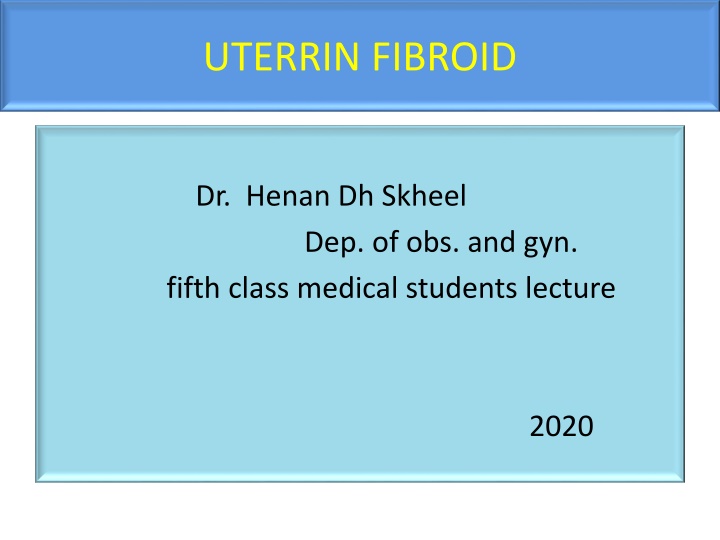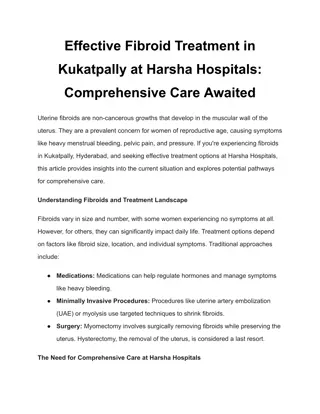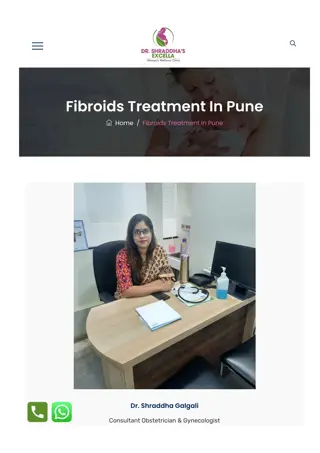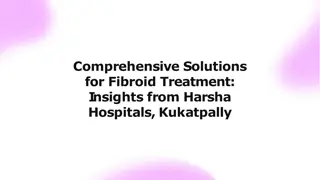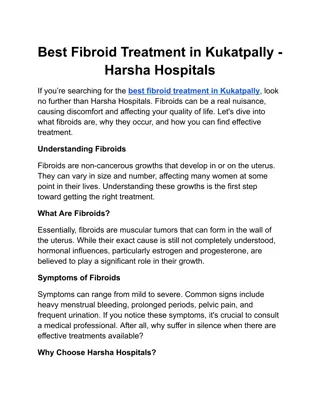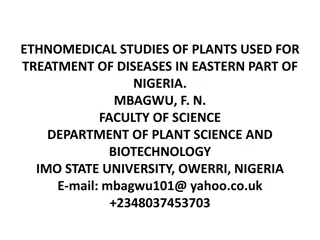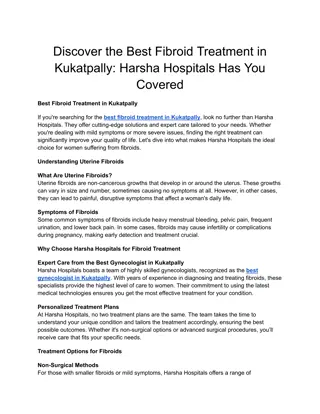UTERRIN FIBROID
Uterine fibroids are common benign tumors in women, arising from the uterine smooth muscle tissue. This article explores their incidence, gross appearance, pathogenesis, and factors influencing their development. Learn about the racial differences in fibroid incidence and the role of estrogen and progesterone in fibroid growth.
Download Presentation

Please find below an Image/Link to download the presentation.
The content on the website is provided AS IS for your information and personal use only. It may not be sold, licensed, or shared on other websites without obtaining consent from the author.If you encounter any issues during the download, it is possible that the publisher has removed the file from their server.
You are allowed to download the files provided on this website for personal or commercial use, subject to the condition that they are used lawfully. All files are the property of their respective owners.
The content on the website is provided AS IS for your information and personal use only. It may not be sold, licensed, or shared on other websites without obtaining consent from the author.
E N D
Presentation Transcript
UTERRIN FIBROID Dr. Henan Dh Skheel Dep. of obs. and gyn. fifth class medical students lecture 2020
Definition and Incidence Uterine fibroids are benign tumors that arise from the uterine smooth- muscle tissue Uterine fibroids are the most common pelvic tumors and the most common benign tumors in women They are also known as leiomyomas and myomas. The true incidence of fibroids is uncertain as many women with these tumours are asymptomatic Fibroids affect around 30 percent of all women by the age of 35 years, and 70 to 80 percent by the age of 50 years. They usually develop between the ages of 16 to 50 years. These are the reproductive years during which estrogen levels are higher. A hysterectomy study has found leiomyomas in 77% of uterine specimens
Grossly Fifroid usually appear as well circumscribed firm tumours with a characteristic white whorled appearance on cross section. Fibroids are paler than the surrounding myometrium and there is usually a very sharp line of demarcation between the tumour and the normal uterine muscle (false capsule) Histologically. Uterine leiomyomas are benign monoclonal tumors arising from uterine smooth muscle cells and fibroblasts . They contain a large amount of extracellular matrix (including collagen, proteoglycan, fibronectin) and are surrounded by a thin pseudocapsule of areolar tissue and compressed muscle fibers. Once a fibroid develops, it can continue to grow until menopause. As estrogen levels fall after menopause, the fibroid will usually shrink. The risk of a fibroid becoming malignant is 0.1%.
The reasons fibroids develop and grow are not well understood, but many factors are recognized as genetic factors, growth promoters, with sex steroids, estrogen and progesterone, being the most frequently studied The initiating events for fibroid genesis remain speculative. The cells proliferate at a modest rate and their growth is dependant on the ovarian steroids estrogen and progesterone .The biologically potent estrogen estradiol induces the production of PR by means of ER- . PR is essential for the response of fibroid tissue to progesterone secreted by the ovaries. Progesterone and PR are indispensable to tumour growth, increasing cell proliferation and survival and enhancing extracellular matrix formation. In the absence of progesterone and PR, estrogen and ER- are not sufficient for fibroid growth. women who start their periods at a younger age are more likely to develop fibroids. Although taking female hormones is linked to fibroids, the use of birth control pills is not. .Childbearing (multiparity) lowers the risk of developing fibroids. The risk reduces each time a woman gives birth and most fibroids shrink after menopause.
There are significant racial differences in the incidence of fibroids, with Afro-Caribbean women having a two- to nine fold greater risk of developing fibroids. In addition, they tend to present at a younger age compared with Caucasian women and have multiple fibroids, higher uterine weights and are more prone to both anaemia and severe pelvic pain . These racial characteristics are more likely to be due to a genetic predisposition Family history Women with a 1st degree relative affected carry a 2.5x increased risk Reproductive factors Some of the most common reproductive factors include nulliparity, early menarche, and the use of oral contraceptives before 16 years of age
Age (peak incidence at 40 to 50). Clinical conditions that seem to increase risk of fibroids include hypertension and diabetes Independent Environmental factors Being overweight or obese increases the risk of fibroids There is also evidence that red meat, alcohol, and caffeine could increase the risk of fibroids, and that an increased intake of fruit and vegetables might reduce it Smoking appears to decrease the risk of fibroid develop
There are four types of fibroid: Intramural: This is the most common type. An intramural fibroid is embedded in the muscular wall of the uterus. Subserosal fibroids: These extend beyond the wall of the uterus and grow within the surrounding outer uterine tissue layer. They can develop into pedunculated fibroids, where the fibroid has a stalk and can become quite large. Submucosal fibroids: This type can push into the cavity of the uterus. It is usually found in the muscle beneath the inner lining of the uterus. Cervical fibroids: Cervical fibroids take root in the neck of the uterus,. Pedunculated fibroids grow on small stalks inside or outside the uterus. It's possible to have more than one type of fibroid
Fibroids may cause very mild symptoms, none at all or symptoms can be severe When patients are symptomatic, the number, size, and/or location of fibroids are critical determinants of its clinical manifestations. Around 1 in 3 women with fibroids will experience symptoms . In women who do feel symptoms, these uterine growths can cause:Pressure symptoms Pressure on the bladder or rectum Frequent urination Constipation and/or rectal pain Lower back and/or abdominal pain If fibroids become very large, they can distend the stomach, making a woman look pregnant Pelvic pain is rare with fibroids and usually signifies degeneration, torsion, or possibly associated adenomyosis and/or endometriosis In the postmenopausal woman presenting with new onset of pain and/or bleeding in new or existing fibroids, leiomyosarcoma should be considered
Period Changes Fibroids may also cause changes to a woman's period, including: Mild to severe cramping and pain Heavier bleeding, sometimes with blood clots (menorrhagia) Increased endometrial surface area, vascular dysregulation, and interference with endometrial hemostasis have been offered as possible explanations Longer or more frequent menstruation Spotting or bleeding between periods Anemia Some women with fibroids who experience unusually heavy bleeding during their periods may become anemic. Many cases of anemia due to iron deficiency from periods are mild and can be treated with a change in diet and iron supplement. Untreated anemia can lead to fatigue and lethargy -- and, in severe cases, heart problems. Other possible symptoms include: Labor problems Pregnancy problems Repeated miscarriages Fertility problems In some instances, fibroids may block the fallopian tubes. Fibroids growing along the inner uterine wall may make it difficult for a fertilized egg to attach
Estimates of the prevalence of fibroids in pregnancy vary depending on the quality of the ultrasound study and the race and age of the women being studied. 18% in African-American women, 8% in white women, and 10% in Hispanic women. fibroids remain the same size or become smaller or increase in myoma size during pregnancy. There is increased risk of malpresentation ,Caesarean delivery ,preterm delivery and postpartum hemorrhage Concern about possible complications related to fibroids in pregnancy is not an indication for myomectomy except in women who have had a previous pregnancy with complications related to these fibroids.. Women who have fibroids detected in pregnancy may require additional maternal and fetal surveillance.
Clinical Features The majority of women with fibroids are asymptomatic they are often discovered incidentally on pelvic or abdominal examination. History Pressure symptoms +/- abdominal distention This includes urinary frequency or chronic retention. Heavy menstrual bleeding Subfertility due to the obstructive effect of the fibroid. Acute pelvic pain (rare): May occur in pregnancy due to red degeneration. This is where the rapidly growing fibroid undergoes necrosis and haemorrhage. Rarely, pedunculated fibroids can undergo torsion.
A solid mass or enlarged uterus may be palpable on abdominal or bimanual examination. The uterus is usually non-tender and irregular compared to gravid uterus Evaluation On physical examination, an enlarged, mobile uterus with irregular contour is consistent with fibroids.
Ultrasonography (transabdominal, transvaginal, contrast sonohysterorography) is the most widely used modality because of its availability, ease of use, and cost-effectiveness. It is particularly helpful to assess myoma growth and the adnexae if these cannot be palpated separately with confidence .Contrast infusion saline or gel sonography and 2D and 3D sonohysterography are very accurate diagnostic procedures to detect submucosal lesions, In women with large fibroids, diagnostic imaging occasionally demonstrates hydronephrosis, the clinical significance of which is unknown. Complete ureteric obstruction is extremely rare. CT is of limited value in delineating the location of myomas relative to the endometrium or myometrium. MRI is the most accurate modality in assessing the adnexae and the uterus because it provides information on the size, location, number, and perfusion of leiomyomas as well as the presence of other uterine pathology including adenomyosis and/or adenomyoma
Differential Diagnosis The major differential diagnoses for uterine fibroids include: Endometrial polyp Ovarian tumours Leiomyosarcoma malignancy of the myometrium. Adenomyosis presence of functional endometrial tissue within the myometrium
The majority of uterine leiomyomas are asymptomatic and will not require therapy. However, 20% to 50% are clinically symptomatic, causing AUB, iron deficiency anemia, bulk effects, and/or reproductive issues, and may require treatment. Treatment of women with uterine leiomyomas must be individualized, based on symptomatology, the size and location of fibroids, age, the needs and desires of the patient for preservation of fertility or the uterus, the availability of therapy, and the experience of the therapist. Symptomatic uterine fibroids may be treated medically, surgically, or with a combination of both
Treatment of fibroid Medical Pain medications, such as acetaminophen, and nonsteroidal anti-inflammatory drugs (NSAIDs), like as ibuprofen or naproxen, can help relieve menstrual cramping. Tranexamic acid (antifebrinolytic) maintain a healthy weight Care for Anemia iron rich food Regular exercise
Expectant Management 3% to 7% of untreated fibroids in premenopausal women regress over 6 months to 3 years. Most women experience shrinkage of fibroids and relief of symptoms at menopause; therefore, depending on the severity of their symptoms, women who are approaching menopause may choose to wait for the onset of menopause before deciding on treatment
Oral contraceptives are effective in reducing menstrual bleeding in the short-term and may prevent the development of uterine fibroids. Progestins/Levonorgestrel Intrauterine System Progestogens are natural or synthetic progestational hormones which may potentially have dual actions on fibroid growth. While the natural hormone progesterone augments epidermal growth factor, which stimulates fibroid growth, it also inhibits insulin-like growth factor-1, which may inhibit growth. Progestogens also down-regulate both estrogen and progesterone receptors in fibroids, which may act as another mechanism in modulating fibroid biology and growth. Both natural progesterone and synthetic progestins cause endometrial atrophy, which has the potential to decrease menstrual blood loss in women with fibroids. that the LNG-IUS significantly reduces menstrual blood loss and uterine volume in women with menorrhagia, with and without fibroids, while it does not significantly reduce fibroid volume. .
Levonorgestrel-secreting intrauterine system (Mirena IUS) This device has revolutionized the treatment of dysfunctional uterine bleeding and evidence suggests that it maybe one of the reasons why the hysterectomy rate has declined over recent years. However, the use of this system in women with fibroids has not been widely studied as some consider it to be a relative contraindication. This may partly be because the device is more likely to be expelled during a very heavy menstruation. It may also be because the presence of a very distorted uterine cavity, which occurs with some fibroid uterii, may make insertion of the device impossible. Intuitively, if the cavity is normal and not especially enlarged, then a trial with the Mirena IUS system maybe appropriate.
Gonadotropin-Releasing Hormone Agonists GnRH agonists are available in nasal spray, subcutaneous injections, and slow-release injections. In general, fibroids may be expected to shrink by up to 50% of their initial volume within 3 months of therapy. However, GnRH agonist treatment is restricted to 6- month interval, following which regrowth of fibroids usually occurs within 12 weeks. Prolonged use of GnRH agonists with estrogen add-back therapy requires However, there is GnRH agonists are useful preoperatively to shrink fibroids and to reduce anemia related to uterine bleeding.
Aromatase Inhibitors (Letrozole). Aromatase inhibitors may serve to block the aromatase activity and growth of leiomyomata. Letrozole, an aromatase inhibitor, inhibits the conversion of androgen into estrogen SPRMs are progesterone receptor that have agonist, antagonist, partial, or mixed effects on progesterone target tissues. Mifepristone is thought to have almost pure antagonistic properties, other SPRMs such as ulipristal acetate exhibit mixed agonist and antagonist properties Ulipristal acetate UPA is an SPRM that also exhibits antiproliferative effects on leiomyoma cells and the endometrium
Effective medical treatments for women with abnormal uterine bleeding associated with uterine fibroids include levonorgestrel intrauterine system, gonadotropin-releasing hormone analogues, selective progesterone receptor modulators, oral contraceptives, progestins and danazol.) Recommendation Treatment of women with uterine leiomyomas must be individualized based on symptomatology, size and location of fibroids, age, need and desire of the patient to preserve fertility or the uterus, the availability of therapy, and the experience of the therapist.
Hysterectomy Hysterectomy is the most effective treatment for symptomatic uterine fibroids. In women who have completed childbearing, hysterectomy is indicated as a permanent solution for symptomatic leiomyomas. The only indications for hysterectomy in a woman with completely asymptomatic fibroids are enlarging fibroids after menopause without HRT, which raises concerns of leiomyosarcoma, even though it remains very rare. Type of hysterectomy The choice and type of hysterectomy, whether it is performed by abdominal, laparoscopic, or vaginal route, should be based on surgeon s training, experience, and comfort and on clinical practice guidelines. The least invasive approach feasible should be used.
Hysterectomy remains the most popular and hence the most common surgical treatment option for uterine fibroids. It ensures immediate resolution of menstrual upset and other fibroid-associated symptoms as well as permanent removal of fibroids. However, it also guarantees infertility, which may not be an appropriate option for some women, and is associated with significant morbidity, a relatively long inpatient hospital stay and prolonged recovery period.
GnRH agonists improvement in preoperative hemoglobin and hematocrit and in reduction of uterine and myoma volumes. Compared with no treatment prior to hysterectomy, GnRH agonists reduce intraoperative bleeding and operative time, increase postoperative hemoglobin and haematocrit values, and decrease postoperative complications and length of hospital stay. They also increase the proportion of hysterectomies performed vaginally rather than abdominally and decrease the proportion of vertical incisions compared with no treatment.
Myomectomy Isan alternative to hysterectomy for women who wish to retain their uterus, regardless of their fertility desire. Removal of fibroids should be considered if they are thought to be associated with heavy menstrual bleeding, pelvic pain and/or pressure symptoms, and in some cases reproductive issues. Disadvantages Although myomectomy allows preservation of the uterus, there is a higher risk of blood loss and greater operative time with myomectomy than with hysterectomy, although the risk of ureteric injury may be decreased with myomectomy. Fibroids have a 15% recurrence rate and 10% of women undergoing a myomectomy will eventually require hysterectomy within 5 to 10 years. Risk of recurrence is associated with age, preoperative number of fibroids, uterine size, associated disease, and childbirth after myomectomy. Women should be counselled about the risks of requiring a hysterectomy at the time of a planned myomectomy. This would depend on the intraoperative findings and the course of the surgery Risk of bowel adhesions ,risk of scar ruptured in subsequent pregnancy
In women who wish to retain their fertility, uterine sparing options must be considered. The first of these is myomectomy, which involves removal of the fibroids only with conservation of normal myometrial tissue. This can be carried out as an open/abdominal, laparoscopic or hysteroscopic procedure. Small pedunculated intracavity fibroids lend themselves to hysteroscopic removal, and this has been documented as being associated with decreased blood loss and improved fertility. Generally, hysteroscopic resection of submucous (and less commonly, intramural) fibroids is restricted to those lesions less than 5 cm in diameter and those where more than 50% of the fibroid is present within the endometrial cavity. Complications to consider during this method of myomectomy
https://teachmeobgyn.com/wp-content/uploads/2016/10/Laparoscopic-Myomectomy-Uterine-Fibroid.jpghttps://teachmeobgyn.com/wp-content/uploads/2016/10/Laparoscopic-Myomectomy-Uterine-Fibroid.jpg
include uterine perforation and the associated potential for visceral damage, haemorrhage, infection and fluid overload. One of the problems with myomectomy is that fibroids are often multiple, such that it is often extremely difficult to remove them all at surgery. Intraoperative blood loss may also be excessive, and in a small number of cases an emergency hysterectomy may be required to control the bleeding. It is very difficult to achieve perfect haemostasis after myomectomy, and postoperative adhesion formation may also be a major problem in some women, further compromising reproductive potential. Some of these issues are likely to be even more significant when laparoscopic myomectomy is performed. Rupture of the uterus in labour is also a risk after myomectomy if the cavity is breached during the myomectomy. This occurs much less frequently with lower- segment Caesarean section.
Uterine Artery Embolization UAE is a procedure carried out by interventional radiologists and consists of injecting an occluding agent into one or both uterine arteries. First described in 1995, it has become one of the most common alternative conservative therapies offered to women with symptomatic uterine fibroids. The procedure is minimally invasive and performed with the patient awake, but it is associated with significant immediate post-procedure discomfort, although recovery and return to function are rapid. Very large uteri (over 20 weeks) may not have a clinically significant response. Single submucosal fibroids or subserosal fibroids may respond better to surgery than UAE This option is still best reserved for women who do not desire future pregnancy. Common complications were vaginal discharge and fever (4.0%)
A number of complications may be associated with embolization and these may be serious, particularly if severe sepsis occurs. In approximately 10% of women, the post-embolization syndrome occurs 7 10 days after the procedure. It consist of malaise and pelvic pain in association with a mild pyrexia and raised white cell count. This is not as a result of infection but is thought to be due to cytokine release at the time of necrosis of the fibroid. The syndrome is often very difficult to distinguish from infection and is treated with a combination of analgesia, adequate hydration, prophylactic antibiotics and reassurance. Another significant problem resulting from embolization is infection.. There is a radiation penalty to the ovaries associated with the procedure which occurs during digital fluoroscopy or with non-target embolization. This, in combination with disruption of uterine blood flow, may increase the chance of ovarian failure in some women after the procedure. Rates of ovarian failure are increased in women over the age of 45 years
Other radiological techniques Laser ablation of fibroids can be carried out at surgery using either a hysteroscope or a laparoscope depending on the position of the fibroids. Laser can also be used with MRI or ultrasound guidance This treatment induces and mechanical damage to fibroid tissue but, unlike UAE, is not associated with an infarction-like syndrome .
Laparoscopic Radiofrequency Ablation of Fibroids Laparoscopic radiofrequency ablation of fibroids is used for women with symptomatic fibroids who want to save their uterus. Benefits of the surgery: Saves the uterus No surgical cuts on the uterus Faster recovery than traditional abdominal surgery done through a large incision
MR-guided Focused Ultrasound for Uterine Fibroids Is a thermo ablative procedure in which focused ultrasound, under constant MR tomographic monitoring, heats the treated tissue in individual small volume increments (sonications) until the planned fibroid volume has been completely denatured. Upon completion of thermoablation, the control (contrast-enhanced MRI) indicates an absence of contrast enhancement in the treated tissue (i.e. NPV = non-perfused volume). The MRgFUS procedure is organ- preserving, non-invasive and can be performed on an outpatient basis. This treatment method is provided by only a few specialized facilitie
Summary box Fibroids occur in 25% of women during reproductive life. Aetiology is poorly understood. Symptoms include menorrhagia, bulk-related problems and reproductive dysfunction. Diagnosis is by clinical examination and TVS. Abdominal ultrasound and MRI may be of additional value in the case of larger fibroids or where there is doubt about the nature of the uterine mass. MRI with gadolinium enhancement is used prior to UAE. Medical treatment is the first line of management in women who present with menstrual upset. GnRH analogues with addback therapy may be used in the short term or as a useful adjunct to surgery in the presence of large fibroids or associated anaemia. The Mirena IUS or endometrial ablation may considered in the presence of a fibroid uterus which is no more than 14weeks in size in the absence of significant uterine cavity distortion. Myomectomy permits uterine conservation but is associated with fibroid regrowth and subsequent adhesion formation Hysterectomy remains a good treatment option for some women but is associated with significant morbidity, a prolonged hospital stay and recovery, and induces infertility. UAE appears to be a promising alternative to surgery for symptomatic fibroids. Other uterine-sparing modalities require further evaluation
